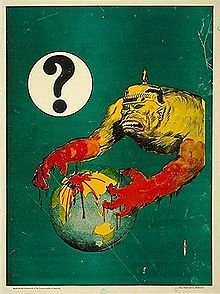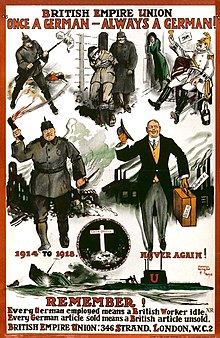Sentimen anti-Jerman



Sentimen anti-Jerman (atau Jermanofobia) didefinisikan sebagai penentangan atau rasa takut terhadap Jerman, penduduk, budaya, dan bahasa Jerman.[2] Kebalikannya adalah Jermanofilia. Sentimen ini sebagian besar dimulai bertepatan dengan penyatuan Jerman pertengahan abad ke-19, yang membuat negara baru itu menjadi saingan kekuatan besar Eropa berdasarkan ekonomi, manufaktur, dan militer.
Abad ke-19
[sunting | sunting sumber]Rusia
[sunting | sunting sumber]Pada tahun 1860-an Rusia mengalami wabah Jermanofobia, terutama terbatas pada sekelompok kecil penulis di Sankt-Peterburg yang telah bersatu bersama sebuah surat kabar sayap kanan. Dimulai pada tahun 1864 dengan penerbitan sebuah artikel oleh seorang penulis (menggunakan nama samaran "Shedoferotti") yang mengusulkan bahwa Polandia diberikan otonomi dan bahwa hak istimewa para baron Jerman di negara-negara Baltik dan Finlandia dipertahankan. Mikhail Katkov memublikasikan kritik keras terhadap artikel tersebut di Moscow News, yang pada gilirannya menyebabkan luapan kemarahan di mana para penulis Rusia menyatakan kekesalan mereka dengan orang Eropa, beberapa di antaranya menampilkan serangan langsung terhadap bangsa Jerman.[3]
Referensi
[sunting | sunting sumber]- ^ Pearl James (2009). Picture This: World War I Posters and Visual Culture. U of Nebraska Press. hlm. 68.
- ^ executive editor, Joseph P. Pickett (2000). American Heritage Dictionary of the English Language, Fourth Edition. Houghton Mifflin. ISBN 0-395-82517-2.
- ^ Marietta Stepaniants (2017). Religion and Identity in Modern Russia: The Revival of Orthodoxy and Islam. Routledge. hlm. 45–47. ISBN 9781351905145.
Bacaan lebih lanjut
[sunting | sunting sumber]- Dekker, Henk, and Lutsen B. Jansen. "Attitudes and stereotypes of young people in the Netherlands with respect to Germany." in The puzzle of Integration: European Yearbook on Youth Policy and Research 1 (1995): 49–61. excerpt
- DeWitt, Petra. Degrees of Allegiance: Harassment and Loyalty in Missouri's German-American Community during World War I (Ohio University Press, 2012)., on USA
- Ellis, M. and P. Panayi. "German Minorities in World War I: A Comparative Study of Britain and the USA", Ethnic and Racial Studies 17 (April 1994): 238–259.
- Lipstadt, Deborah E. "America and the Memory of the Holocaust, 1950–1965." Modern Judaism (1996) 16#3 pp: 195–214.
- Scully, Richard. British Images of Germany: Admiration, Antagonism & Ambivalence, 1860–1914 (2012)
- Tischauser, Leslie V. The Burden of Ethnicity: The German Question in Chicago, 1914–1941. (1990).
- Wingfield, Nancy M. "The Politics of Memory: Constructing National Identity in the Czech Lands, 1945 to 1948." East European Politics & Societies (2000) 14#2 pp: 246–267. Argues that anti-German attitudes were paramount
- Yndigegn, Carsten. "Reviving Unfamiliarity—The Case of Public Resistance to the Establishment of the Danish–German Euroregion." European Planning Studies 21.1 (2013): 58–74. Abstract
Pranala luar
[sunting | sunting sumber]- "Nobody Would Eat Kraut": Lola Gamble Clyde on Anti-German Sentiment in Idaho During World War I (Oral history courtesy of Latah County Historical Society)
- "Get the Rope!" Anti-German Violence in World War I-era Wisconsin (from History Matters, a project of the American Social History Project/Center for Media and Learning)
- "We Had to Be So Careful" A German Farmer's Recollections of Anti-German Sentiment in World War I (Oral history courtesy of Latah County Historical Society)
- Article from Der Spiegel 31/10.2006 on Polish–German Relations
- Article from Allan Hall in The Scotsman 11 July 2003: "Why do we still laugh at Germany?"
- Newspaper articles from 1918, describing the lynching of Robert Prager in Collinsville, Illinois
- Bank weathered anti-German hysteria, Great Depression – Pantagraph (Bloomington, Illinois newspaper)
- German-language paper under suspicion during WW I – Pantagraph (Bloomington, Illinois newspaper)
Text is available under the CC BY-SA 4.0 license; additional terms may apply.
Images, videos and audio are available under their respective licenses.
